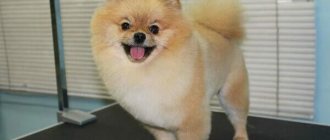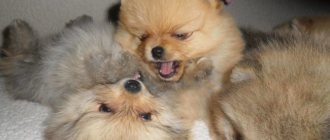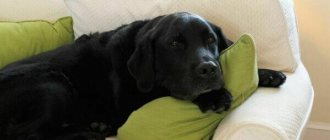A small funny dog that looks like a fluffy bear cub is actually a distant descendant of an ancient canine family that was formed without the participation of breeders. The genome of Spitz-type dogs is closest to that of a wolf, hence the good health, high intelligence, and independent character of the pet. Owners of a Pomeranian often see it only as a toy and spend little time training their dog. This is fundamentally wrong. An ill-mannered dog is a source of problems not only for the owner and his family, but also for everyone around him.
Features of raising a Pomeranian Spitz
Among the ancestors of the Pomeranian Spitz there are excellent hunters, strong sled dogs and reliable guards. The Pomeranian is an ornamental breed, but its psychology and character are inherited from natural leaders, the leaders of the pack. The dog is stubborn, independent and very smart. He is also a cunning manipulator with a sweet little face.
If you raise a baby without proper training, the Pomeranian very quickly assesses the situation and begins to shamelessly take advantage of its privileged position. He loves to stage “performances”, demonstrates resentment, and is capable of throwing a hysteria worse than a tragic actress. And what is an unhappy face worth if the poor dog is not given a tasty morsel?
Loud yelling and corporal punishment will not solve the problem of training a Pomeranian. It is necessary to establish a connection between the animal and the person, to learn to understand the needs of the pet. Persistence and encouragement instead of shouting and punishment will give good results, and most importantly, they will bind the owner and pet into a strong friendship.
How to properly raise a Pomeranian Spitz?
Pomeranians are very playful and cheerful by nature. It's not just little puppies that love to play. Adults are also not averse to taking part in the fun. Training needs to be built on this weakness. Classes are turned into comic competitions, where the prize is a tasty piece and the owner's affection. You shouldn't turn your studies into work. You need to train a Pomeranian Spitz casually, without focusing on what is happening.
boy
Orange Spitz boys are stubborn “leaders of the pack.” They try to dominate everyone who comes into their social circle. And if you can’t subdue someone by force of character, natural acting talent comes into play. The owner does not want to fulfill the “legal” demands of the pet? The petty deceiver immediately becomes sick, unhappy, refuses food, and slowly and sadly leaves these unjust people.
girl
Training a female Pomeranian is a little easier. She does not have the makings of a tyrant like the boy, but her acting abilities and penchant for manipulation are no worse. An affectionate and flexible girl will not insist on her own way, but will achieve everything she wants with the help of a sweet little face and pleading eyes. In extreme cases, hysterics with howling, squealing and whining are used. Moreover, the young lady is capable of hysteria until the owner gives up.
Raising a Spitz by month
Educators and teachers know very well the simple truth: re-teaching is more difficult than teaching from scratch. If you immediately teach your Pomeranian “what is good and what is bad,” then in the future you will be able to avoid many troubles. Typically, regular training begins at the age of 2 months. But if the puppy appears in the house before this time, he will have time to “pick up” bad habits, which he will then have to wean off.
Depending on age, Pomeranians are taught the following skills:
- 1-2 month. Know the situation at home, your place, the purpose of the tray and prohibiting commands. Little by little they learn to get used to their nickname.
- 3-4 month. This is the stage of socialization. Acquaintance with the world continues, but outside the home. The habit of going to the toilet outside is developed. There is a ban on food from someone else's hands.
- 5-6 month. Start of full-time classes. The ability to walk next to the owner, return on demand, stand, sit and lie down on command.
By six months, the Pomeranian needs to be taught basic commands. This is adolescence for a dog with all the ensuing problems: rebellion and ignoring the owner, a test of the strength of the owner’s character.
Training with a dog handler can begin simultaneously with the start of walks on the street, when quarantine ends after the second vaccination.
How to stop biting
Puppies during the period of changing teeth (3-4 months) are looking for something to bite. And, usually, they choose the legs and arms of the owner. But this behavior will become a habit and subsequently will no longer be funny if the Spitz is not weaned from biting at an early age.
First of all, the baby must understand that human body parts are not a toy. Therefore, when the dog wants to bite someone, offer him a ball or a squeaker.
When a puppy bites his fingers not on purpose, but out of interest or boredom, it is better not to pay attention to it, but not to give him a reason to behave this way next time.
There are developed training schemes that help to wean a Spitz from biting.
- When the puppy is calm and well-fed, hold your hand in front of his muzzle. If the baby does not react, he should be praised and treated with a treat. Otherwise, pull your hand back and sternly say: “You can’t!” The training is carried out 2-3 times daily.
- If your Spitz wants to bite, hide your hands behind your back. When he calms down, snap your fingers in front of his nose and give him a treat. Repeat several times.
Is it difficult to train a Pomeranian?
The Pomeranian breed is famous for its intelligence, and these small dogs are usually not difficult to train. The culprit of gaps or defects in upbringing most often becomes the owner himself.
Common mistakes in training:
- Lack of human persistence. The pet instantly “sits on its head” as soon as the owner gives in once.
- Elevation of the little Pomeranian cunning man to the rank of “master of life.” He loves to dominate. The slightest mistake in training, and the whole life of the family revolves only around the furry tyrant.
- Tenderness and delight at the dog’s appearance. A smart manipulator subtly senses the emotions of those around him, understands when he is admired and takes full advantage of this, forcing the owners to “dance to their tune.”
When training, you need to be prepared for insubordination, cunning and hysterics. If the owner’s actions somehow infringe on the pet’s freedom or desires, a gala concert is inevitable. However, high intelligence helps the dog quickly remember commands and correctly assess the “carrot and stick” situation.
Characteristics of Spitz
It is impossible to breed obedient Spitz dogs without understanding their psychology and temperament. First of all, it is worth knowing that a dog thinks differently than a person. He does not build complex logical chains; he acts on the basis of innate instincts and acquired reflexes.
It is on instincts and reflexes that the education of a Spitz is based. It is necessary to develop the dog’s natural qualities and build the right associations: “a good deed is a reward”, “a bad deed is a punishment”.
The Pomeranian is an open and intelligent dog that quickly learns commands and tries to please its owner. Anyone can manage their own learning. But sometimes education slows down, and the dog turns into a spoiled tyrant.
The reasons for unsuccessful training lie in the negative aspects of the Spitz’s character. They:
- Stubborn. Pets resist to the last and obey only when they understand that the owner will not back down;
- Dominant. If trained incorrectly, the pet will think that he is in charge and will do everything to make his owners’ lives revolve around his desires;
- Manipulators. In this, dogs have no equal, they subtly feel the emotions of people, understand how charming they are, and take advantage of it.
The German Spitz is an artist, what else should you look for? The dog skillfully puts pressure on the owner’s pity, guilt and love. Among the manipulator's arsenal:
- sad or pleading faces;
- resentment - going to another room, unwillingness to communicate with the owner, refusal to eat, play;
- tantrums - Spitz squeals worse than piglets when trying to punish them, send them to their place, tie a leash and other actions that violate the freedom of pets.
- barking, whining, howling;
Keep in mind that Spitz loves to play. Plus, both puppies and older dogs have fun. Therefore, the lessons are made comical, carried out as if by the way.
The character of a German Spitz boy is more domineering and stubborn, while that of a girl is obedient and affectionate. But they both masterfully manipulate people.
At what age can a Pomeranian be trained?
The Pomeranian is ready to start training almost from birth. From the very first minute of acquaintance, the owner must establish rules that cannot be broken. Making allowances for infancy and an immature mind is dangerous; the pet remembers all the concessions from the person and in the future requires the same lenient attitude towards itself.
You can start training by training your puppy to use the litter tray. First, they prepare the place where the dog toilet will be: they remove everything that might interest the pet. A small puppy perceives rugs, carpets and rags as a suitable place to relieve itself. It is better to remove these things until he learns to use the litter box. After eating or sleeping, you need to take the puppy to the litter box and wait for it to do its business.
When to start training
Dog handlers are still debating about the age of dogs and when to start training. Some people believe that the younger the Spitz, the easier it is for him to remember commands.
Others are sure that small dogs are absent-minded, often distracted, cannot concentrate, and therefore difficult to train.
One way or another, there is one general rule - they begin to raise and train a puppy from the first days of arrival in the apartment. And tricks can be taught later: at 3–12 months.
For training each team, there is an ideal puppy age when training is most effective.
Where to start training?
Like any science, education requires a systematic approach. Basic rules of training:
- Regularity. You cannot train a Pomeranian spitz from time to time. You need a clear schedule from which you should not deviate. But this does not mean that a Pomeranian child should be forced to work with threats. The owner will have to come up with (find a description in the literature, get advice from a specialist) fun activities where the material is presented in a playful way.
- Repetition is the mother of learning. At the beginning of each lesson, you need to repeat all the completed commands. If the knowledge has not yet been consolidated, you should not give new material.
- Patience. The baby will definitely make mistakes. You can’t react too harshly to them and poke your puppy’s nose into a puddle every time. It is worth showing dissatisfaction, but avoid shouting and anger.
- Alternating rewards and punishments. For every success, even minor success, the pet should be praised and rewarded. And the punishment for wrongdoing should not be excessive.
- The right time and place. Training will give results if the puppy does not become distracted by the environment, people or other animals. On the street you need to find a separate place where there are no objects of interest to the baby. You should not train in the house with a large crowd of people.
The owner's dissatisfaction should be caused by aggression towards other animals, “empty” barking, and the desire to dominate. You should start with the simplest commands and do not move on until the material is mastered. Pomeranians, like all animals, are very susceptible to human intonations and emotions. Prohibitory commands (“Ugh!”, “You can’t!”) are given in a stern voice, and the rest must be pronounced confidently, but not aggressively.
The Pomeranian should not be allowed to carry out commands voiced by a stranger.
About the hierarchy in the house: who is in charge?
How effective the training will be largely depends on how quickly the pet learns to comply with subordination. From the moment the dog appears in the house, it must understand that the authority of the owner is an unconditional and constant value. This is not as easy to achieve as it seems at first glance, because the appearance and behavior of the Pomeranian is conducive to being loved and pampered, and even turning a blind eye to pranks.
You need to say goodbye to the involuntary desire to constantly pamper everyone’s favorite
The Spitz grasps everything on the fly and can quickly assess the situation. When the dog realizes that he has become the leader among people, he will never give up leadership voluntarily. Only an experienced dog handler can change the behavior of an adult dog that imagines itself as a leader. To avoid such a situation, you should raise your Pomeranian systematically and patiently.
Consultations on education can be taken from both breeders and trainers
The breeder from whom the puppy was purchased can provide invaluable assistance in this matter. People who devote themselves to professional dog breeding, as a rule, are well aware of the character traits of the breed and do not refuse owners advice.
What can you teach a Pomeranian?
It is worth starting training with the basic commands. You cannot teach a bear, fox, or toy Pomeranian to sit or run next to its owner before the puppy has mastered the basics well.
Knowledge and skills developed through proper training.
| Basic Commands | Characteristics of the actions of the owner and the dog |
| "Name" | The puppy must remember its name and respond to it unquestioningly. You should not choose an intricate long name for your pet, so as not to complicate training. |
| "Ugh!" | This is not a cry of disgust, but a warning of danger. When a puppy shows attention to something dangerous (object, food, situation), you need to give a command in a stern voice with clear articulation. In addition, you can slightly tighten the leash (do not pull too hard). |
| "It is forbidden" | This is not the same as “Ugh!” The command means that the dog must stop the action that is happening at the moment (barking for no reason, begging, trying to dominate, etc.). The command must be given in a confident tone that does not allow for objections. |
| "Place" | The puppy must know where this very place is. Before training, you need to arrange for him to lie down. The first time the command is performed by the owner himself (pick up the pet, carry it to its place and be sure to praise it). |
| "To me" | The command is pronounced confidently, kindly, and is accompanied by a slight pull on the leash. When reinforcement with a leash is no longer required, you need to praise the puppy especially actively. |
| "Sit" | This is an intermediate option between simple and complex commands, the beginning of raising a truly disciplined dog. The dog should stand at the owner's side on a short leash. Then they pronounce the puppy’s name and confidently give the command, while lightly pressing the dog’s sacrum. Use a leash to slightly lift the front part of the body. When the Pomeranian follows the command, he is sure to be praised and rewarded. |
Command "Near!" - this is the next level, allowing the owner and dog to feel confident in any crowd of people. The dog should stand close to the person’s left leg (pull it slightly with a leash). When moving, the puppy may change direction or speed. The owner carefully corrects the behavior with the help of a leash. Every success is sure to be rewarded.
First commands are the basis of obedience
Simultaneously with the “Place” command, teach the Spitz to its nickname. A dog's name is the main command through which you establish a connection with it. The voice in which you pronounce the name will help your pet understand what awaits him next. Say the name before each command to get attention.
It’s good if the Spitz has learned to go to a place on your order and readily responds to the nickname. It's even better if he starts coming when you call him. To do this, use the “Come to me” command. To help your dog understand the meaning of the command faster, at first combine it with feeding time or a favorite game, such as ball.
Food for a Spitz is a powerful stimulus, with the help of which you can also teach him the commands “Stand”, “Sit”, “Lie down”. The command “Wait” will also not be superfluous, as it gradually develops endurance in the animal. If you teach your dog to restrain his desires and impulses, you will also cope with his dominance.
Types of dog training
Mandatory skills that a pet must acquire as a result of training:
- basic command training;
- friendly communication with others (without barking, dominance or aggression).
Dogs can be trained in different ways:
- independent studies;
- training under the guidance of a dog handler;
- joint training (owner + dog + dog handler).
Each of the schemes has pros and cons. Training an energetic and confident dog requires patience, sometimes almost angelic, and firmness. If the owner of a dog of the Dwarf Spitz breed has these qualities, then you can do the training yourself. But to be on the safe side, it wouldn’t hurt to contact a dog handler, at least at first.
Classes with a dog handler
Only the puppy and the specialist participate in the training process. The owner receives an obedient, well-mannered dog. The advantages of the scheme are that the dog handler will not only teach the pet basic commands, but also prepare it for exhibitions. Disadvantages of the method: the owner will be separated from his pet for a long time. When the “prodigal dog” returns to the house, both the owner and the dog will have to get used to each other again. In addition, it is quite expensive to train a Pomeranian from a qualified dog handler.
Lessons with the owner
The most difficult, but most effective option. If the owner can become a mentor-guru for the Pomeranian Spitz, then in the future you can train the dog without any problems. The Pomeranian recognizes the person as the “leader of the pack”, learns to respect him and obey him unquestioningly. There is only one drawback to the training scheme, but it is very significant: complete dedication is required. You will have to read a mountain of specialized literature, be patient and have time.
Joint training at the dog training center
Joint training takes place at the canine center under the guidance of professionals. Training, which involves the owner, the Pomeranian and a dog handler, is a reliable and informative option. The owner gains invaluable training experience. The pet learns not only basic commands, but also how to interact with other animals and people. The main advantage of joint training is that the owner and the dog do not have to be separated and then get used to each other again. Their connection will only strengthen during classes.
Tips from dog handlers for self-study
If you decide to start raising a Pomeranian on your own, dog experts advise adhering to the following rules:
- consider the character of the pet;
- if difficulties arise, seek help from specialists;
- do not make concessions or exceptions to the established rules for your Spitz;
- Walk your pet daily to release its energy;
- avoid physical punishment;
- engage in social adaptation of your pet;
- do not separate play and learning;
- control barking;
- do not succumb to provocations from the animal and do not allow it to dominate.
In training
Once you have acquired such a beauty as a Spitz, don’t put your upbringing on the back burner. Follow the recommendations of specialists and remember that the future character of an adult dog and the quality of your life together depend on the quality of training.
How to teach your Pomeranian commands and tricks yourself?
First of all, a small Spitz puppy should be taught prohibitive commands, and only then can you proceed with the rest. Two main prohibitions: “Ugh!” and "You can't." They are trained with food or toys. You need to place a tasty morsel or ball close to the dog or hold it in your hand. This is followed by a prohibition command. Reward is given only after the pet stops reaching for food or a toy.
Pomeranian Spitz training:
- The “Give” command is taught using something. When a pet approaches its owner with a toy in its mouth, a command follows and the person carefully removes (does not pull!) the object from its mouth.
- The order “Come to me” is taught through food. The owner holds the piece in his hand, pronounces the command and rewards the pet after it is completed.
- The “Place” command is first performed by the owner instead of the pet. The puppy is picked up and carried to the bed, repeating the command. If the dog remains on the bedding, he is rewarded.
- “Voice” is the easiest command for a “talkative” dog. The owner raises the treat higher, but does not give it to the puppy until it barks.
It is better to learn complex commands under the supervision of a dog handler, especially if the owner is a novice dog breeder.
How to teach your dog the “Down” command
To introduce your dog to the command “Down!” Several methods are used. You need to choose one of them and stick to it until graduation. Treat training is great for puppies, while strength training is great for adult dogs.
With a treat
The simplest and most effective method. Exceptions are dogs whose character pushes them to perform actions not for a treat, but for fun.
How do training sessions with treats work:
- The trainer holds the leash in his hands, the dog is on his left side.
- You need to show your pet a treat and get him interested. Then you should clearly say “Lie down!” and slowly move the hand with the reward forward and down so that the dog reaches for the hand.
- The dog is held by a leash at all times and remains in place. By moving its head towards the treat, the pet will begin to gradually lower itself and take a semi-lying position.
- Press slightly on the withers so that the pet finally lies down. When he is in the desired position, say “Okay!” and give the reward.
- It is important that the dog receives and eats the treat while lying down. If he got up earlier, repeat the manipulation.
- During the first lessons, you can hold your pet in a lying position for 5 seconds, and then give the command “Walk!” (if it is already known).
The skill needs to be practiced. Repeat the exercise several times, alternating between exercises and rest breaks. If you are training outdoors, return home and try to repeat the trick in your own home - so that the “university” of the command is established in the animal.
No treats
This method involves the use of a leash. It is designed for animals that know the “Down” command, but are reluctant to perform it. This is also an excellent method for consolidating a skill. Teaching a dog the “Lie down” command according to this method goes like this:
- Put a leash on your pet.
- Place one hand on the dog's withers and grab the leash with the other.
- Start simultaneously pressing on the withers and pulling the leash down and forward at the same time.
Be careful: do not jerk your pet and make sure that it does not fall over on its side and that its paws are gently stretched forward. This is necessary so that the pet does not get injured.
With hook
You can try to carry out training without treats - the method is suitable for obstinate or adult individuals. In this case, the trainer’s left hand is located on the dog’s withers, and the right hand picks up the pet under the front paws.
After giving the command, you need to gently press on the withers and with your right hand, slightly knocking (hook), move the front paws forward. When the dog takes a lying position, it should be praised and rewarded. After a five-second stay in a lying position, the dog is released with the command “Walk!”
It is important to immediately correct the dog's position when it follows the command. The body should be positioned in a straight line, without falling to the side. The front legs are extended forward, the hind legs are tucked in.
With a gesture
When the pet begins to follow the command well, it is worth adding gestures to the word “Lie down”. Over time, the animal will learn to perform an action by gesture, without words. The "down" command for dogs looks like this:
- the right arm is raised horizontally;
- palm facing up;
- to execute the command, the hand is lowered to the right thigh (at this time the dog should lower itself in unison with the hand).
Breeds that respond well to training can be initially taught to lay with voice and gesture, later leaving only the gesture.
Features of training a Pomeranian Spitz at home
The main rule of training is to establish a hierarchy. The pet must understand “who’s boss.” This can be achieved as follows:
- feed the dog only after the owners have eaten;
- the person goes through the door first;
- during a walk, the Pomeranian Spitz walks slightly behind the owner and does not rush far ahead;
- establish a strict ban on eating from the master's table and being on the bed;
- the beginning and end of classes or games is set by a person;
- any aggression is stopped immediately and firmly.
A daily routine will help your Pomeranian consolidate the skills and habits it has developed. A combination of physical influence (lightly press on the croup, pull the leash, guide with your hand) and encouragement will help teach the correct execution of commands.
Types of training
You can teach a German Spitz basic commands using 3 training methods:
- Cynological. Suitable for beginner dog lovers. The pet is sent to a training school, where professionals work with it. Result 100%. Disadvantages: separation for 2-4 weeks, lack of relationship with the owner.
- Joint. The owner works with a German Spitz under the supervision of an instructor. The most reliable method. In addition, classes will be more necessary for a person than for a dog - he needs to learn how to interact correctly with a pet, understand him and speak the same language with him.
- Independent. Training a Spitz at home is not difficult, even if you have no experience. The main thing is to study thematic literature and videos. Plus – free training, building close relationships. And if something doesn’t work out, you can always contact a dog handler.
With any type of training, the dog can be taught using three different approaches to training:
- incentive - the pet is treated or praised after correctly following orders;
- mechanical: the owner helps the dog carry out the command - he presses on the withers, croup, pulls the leash, pulls it away with his hand, this way you can start the first training;
- contrasting - both methods of training are used.
Any training method is good. But it is better to resort to contrast - the German Spitz quickly learns commands that are simultaneously reinforced by physical influence and praise.
How to play with a Pomeranian at home?
Pomeranians are playful by nature, and a well-trained pet also clearly understands when to play and when to leave the owner alone. Lesson options:
- wrap a tasty piece in a napkin or handkerchief and invite the dog to get it himself;
- hide the food in a drawer in front of the dog, close it loosely and allow the dog to get a piece;
- tie a piece of fairly dense food (for example, a pig's ear) to a long string and push it far under the furniture, inviting the dog to pull the food out by the rope;
- leave the pet alone in the room, close the door loosely and call the dog (he must cope with the obstacle on his own).
You can train your Pomeranian to jump through a hoop or jump rope, overcome a “scary” tunnel made of a blanket on stools, or fetch a toy.
Character and temperament
Spitz are springs that are always active and cheerful. There is no need to wind them up; they will play and have fun all day long. We can say that these animals never lose heart.
Due to hyperactivity, children sometimes become uncontrollable.
Another negative trait of the breed is stubbornness. Spitz dogs do not resist out of malice, but because they do not want to waste time on training when it could be spent with other dogs or doing something else interesting. Therefore, training a Pomeranian should resemble a game.
Interesting! A well-trained Spitz restrains its emotional impulses in order to please its owners.
Tips for care and training
A well-bred Pomeranian Spitz will not cause big problems in its maintenance. Caring for your pet consists of regular brushing, brushing teeth and ears, trimming nails and bathing. It is better to entrust monitoring of the condition of teeth to a veterinarian. Brushing can be turned into a kind of ritual, at the end of which the dog receives encouragement. You can trim the nails yourself, but for the first time it is better to watch a professional work. Bathing your Pomeranian completely is not recommended, especially during shedding. The maximum “water procedures” is washing your paws after a walk.
In some cases, care and training can be combined. For example, when a dog first arrives in the house, you can spread several diapers around the dog's toilet. As soon as the puppy goes to one of them, it is transferred to the tray and left until the next time. If he again goes somewhere to the side, a new soiled diaper is transferred to the tray. The number of diapers is gradually reduced, removing those that remain clean.
The main commandment of training is the same law for everyone and for all times. You cannot indulge your pet, even if he is sick. Proper upbringing shapes character:
- a trained dog follows the command the first time;
- the dog must know that the owner will stroke and praise him only for good behavior;
- At the beginning of training, the Pomeranian Spitz should be addressed only by name, no “babies”, “fluffies” or other words that the dog does not understand.
Cruelty, constant yelling and scolding are a bad choice. They begin to teach with the simplest concepts and gradually increase the complexity of the tasks. Ideal conditions are required (no irritating or distracting factors). All commands are pronounced in a confident tone that does not allow for objections.
Where and when to train a dog
Cynological practice shows that dogs are quite amenable to training from the age of 1.5 - 2 months . Accordingly, you can start introducing the first commands to the puppy at this age, provided that the baby has learned his name. Young dogs, during a period of active growth, have an increased appetite, which simplifies training using the reward method.
The first acquaintance with the “lie down” command should begin at home, in a well-known environment where nothing distracts the puppy. The pet should be walked - this makes it easier for him to concentrate on the trainer. You can move into areas with extraneous stimuli only when the dog has mastered the order and clearly understands what they want from him.
Training with an adult dog, as well as with a puppy, begins in a well-known place, and distractions are added gradually.
Useful skills and commands
The most important skills to teach your puppy first are knowing his name and getting used to the toilet. It is useful to show your Pomeranian the difference between the “Voice!” commands. and “Quiet!” If the dog starts barking loudly, the owner gives the command “Voice!”, and then carefully covers his mouth with his hand and gives the command “Quiet!” Success is definitely rewarded. In addition, the following commands can be included in Pomeranian training: “Give me a paw”, “Fetch”, “Bow”.
Toilet training
When a puppy first comes into the house, he is surrounded by strange, frightening smells. A tray with a diaper, on which even a faint trace of the dog’s urine or feces remains, will be the first place with a familiar smell. The baby is immediately placed in a tray covered with a diaper and is not released until he relieves himself. “Victory” is rewarded with affection and encouragement, and then you can let him go and get acquainted with the situation.
If your pet has ever stepped on the carpet, he will repeat it again and again.
Nickname
The Pomeranian Spitz perceives a short, sonorous name more easily and remembers it faster. The pet's name should be pronounced affectionately, in a calm voice. Every time there is at least some kind of reaction (the puppy turned its head, looked, made a movement towards the owner), it needs to be reinforced with encouragement. Food reinforces the skill well. If, after pronouncing the nickname, the dog runs up to the owner, he should receive a tasty piece. Before feeding, you need to call the puppy, attracting his attention, and only then put the bowl on the floor.
Alone at home
When a beloved owner leaves home, the puppy may decide that this is forever and “cry” from fear and loneliness. This moment will have to be endured. You can’t go back and console the baby. Over time, he will understand that the owner will definitely return. Also, you should not react to a pet’s whining if the person has gone into another room or is not paying attention to it. Once the Pomeranian understands that whining is a reliable way to attract the owner, he will shamelessly manipulate it. Toys, special edible bones and balls will help protect your home environment from the consequences of interacting with a curious and mischievous puppy.
Weaning off barking
If loud barking is caused by an objective reason (the dog feels danger, is scared or alarmed by something), you cannot punish it. A negative reaction is only needed in cases where the pet voices for no reason. The only way to wean him off “empty” barking is to distract attention with a loud sound, call him to you or give any familiar command, and then say in a firm voice: “Quiet!” You cannot shout or scold your pet loudly. This causes anxiety and confusion, and the animal may think that the owner is also barking. When the dog follows the command, he must receive a reward.
What is needed for training
Before you start learning something new, you need to prepare everything you need. This is not difficult, since you will need the most common devices:
- Comfortable collar
. This is a mandatory item - it is used to control the pet.
- Short leash
(2 m). It will be needed not only for classes, but also for moving to the training site.
- Reward
. This is usually a treat. But do not take regular food - it will not interest the dog and will not become a motivator. Tasty pieces should not be too large, otherwise the dog will quickly get full and lose interest in activities.
- Good mood
. A very important factor, since dogs sense the emotional mood of the owner very well. Only in a calm, friendly environment can a positive result be achieved.
If you're exercising outdoors, bring a couple of toys to keep your dog entertained after the workout.
What to do if your Spitz doesn't listen?
Before punishing your Pomeranian, you need to find out the reason for the bad behavior. Perhaps the dog is afraid of something or is accustomed to permissiveness. If your dog has been obedient all along but suddenly changes, it may be sick or very tired.
Punishment is the same part of training as encouragement, but you need to point out your pet’s mistakes correctly:
- Punishment must always be deserved. You can’t take your bad mood out on a dog that turns up at the wrong time.
- Punishment must be made at the time the offense is committed or immediately after it. If some time has passed since the “crime,” the animal will not understand why the owner is dissatisfied.
- Prohibitions are the law for the dog and the owner. For example, if it is forbidden to take food from someone else's hands, the owner should not allow or provoke such a situation.
- Lack of encouragement is also a punishment. Affection needs to be dosed.
- Ignoring the owner must be punished immediately. This may be a stern shout, a threatening tone, but you cannot hit your pet, especially with your hand.
The owner's hand is what strokes and caresses. If corporal punishment is really necessary, you can take a rolled up newspaper, a towel or a thin twig.
Games and treats - yes, anger and screaming - no
Spitz dogs respond well to training, trying to please the owner. If for some reason your pet cannot understand for a long time what exactly to do, do not even think about yelling at him or hitting him. This will not speed up the process, but will only scare the student. In this case, he will either refuse to make contact with you, or will grow up in constant fear. A cowardly, aggressive or disobedient dog is not a characteristic of Spitz dogs, but the consequences of improper training.
It's better to show the dog his favorite toy, for which he may want to do what is needed. Kind words of encouragement will also help. For each execution of a command, reward your Spitz with a treat, a kind word and a gentle pat on the withers. During training, the pet must be half-starved in order to do anything for a treat.
Give commands clearly and emotionally. Having chosen one word for a command, use only that word, otherwise the dog will get confused. And always pay attention to her mood. If she does not want to exercise, it is better to postpone the training. The same needs to be done if you are not in the mood. By following these simple rules, you will soon notice how your dog is making great progress.











